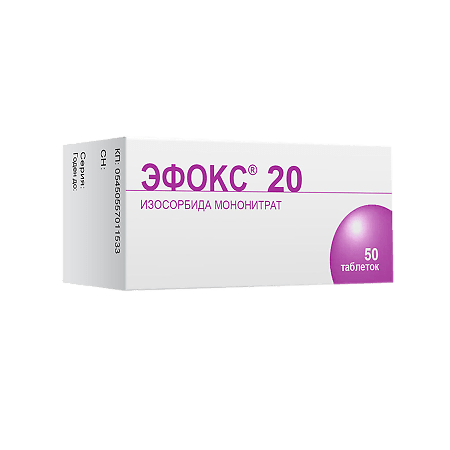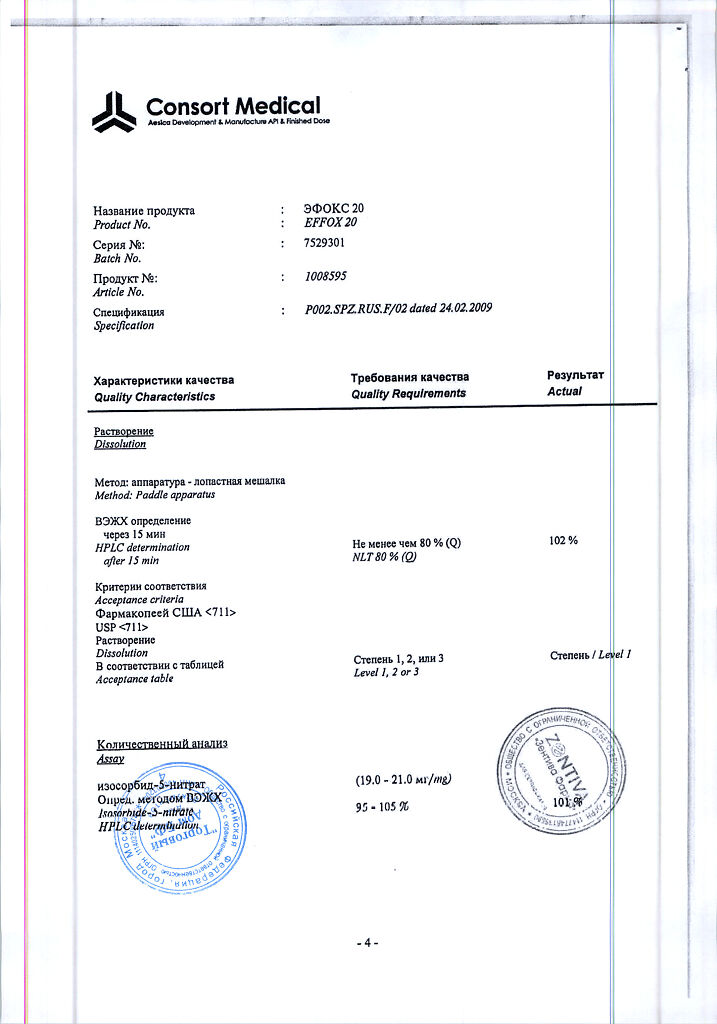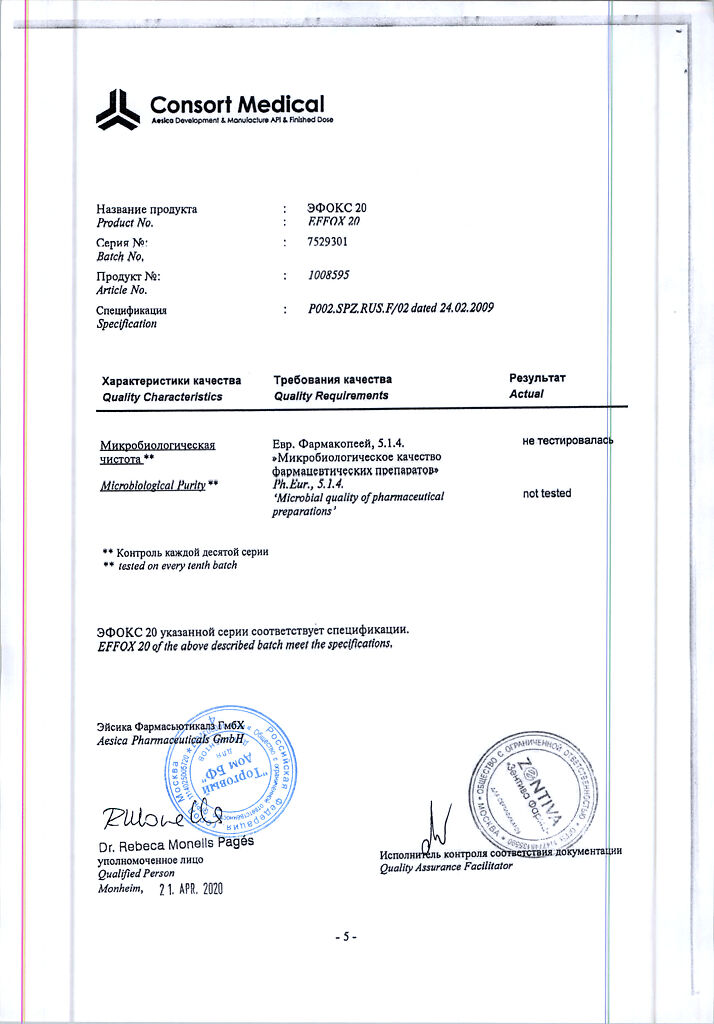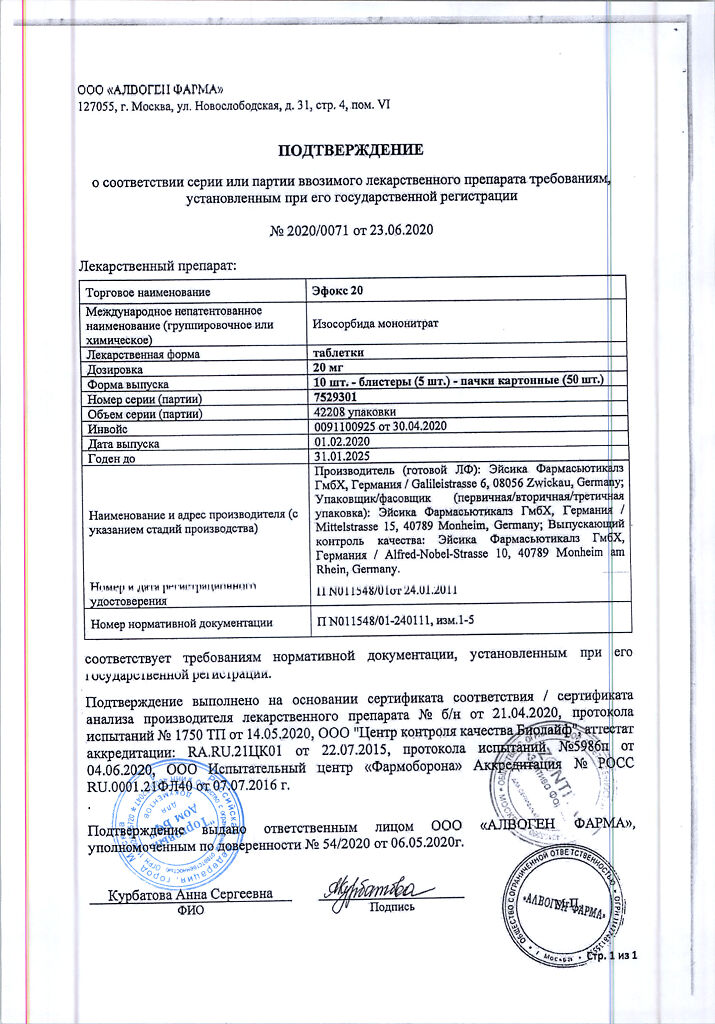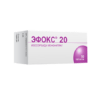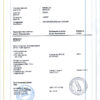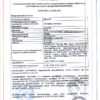No products in the cart.
Efox 20, tablets 20 mg 50 pcs
€4.52 €4.01
Description
An antianginal drug, organic nitrate. Peripheral vasodilator with predominant effect on venous vessels.
Stimulates the formation of nitric oxide (endothelial relaxing factor) in the vascular endothelium, causing activation of intracellular guanylate cyclase, the consequence of which is increase of cGMP (mediator of vasodilation).
Limits myocardial oxygen demand by reducing preload and postload (decreases left ventricular end-diastolic volume and reduces systolic wall tension). It has coronary dilator effect.
Limits blood flow to the right atrium, decreases the pressure in the small circle of the circulation and regresses the symptoms of pulmonary edema. Helps redistribute coronary blood flow in the area with reduced blood flow.
Enhances exercise tolerance in patients with coronary artery disease and angina pectoris.
Dilates the vessels of the brain, dura mater, which may be accompanied by headache.
As with other nitrates, cross-tolerance develops. After withdrawal (interruption of treatment), sensitivity to it quickly recovers.
The antianginal effect occurs 30-45 min after oral administration and lasts up to 8-10 h.
.
Indications
Indications
Prevention of angina attacks in patients with coronary artery disease, incl. after myocardial infarction.
Chronic heart failure (as part of combination therapy).
Pharmacological effect
Pharmacological effect
Antianginal drug, organic nitrate. Peripheral vasodilator with a predominant effect on venous vessels.
Stimulates the formation of nitric oxide (endothelial relaxing factor) in the vascular endothelium, which causes activation of intracellular guanylate cyclase, resulting in an increase in cGMP (a mediator of vasodilation).
Reduces myocardial oxygen demand by reducing preload and afterload (reduces the end-diastolic volume of the left ventricle and reduces the systolic tension of its walls). Has a coronary dilating effect.
Reduces blood flow to the right atrium, helps reduce pressure in the pulmonary circulation and regression of symptoms of pulmonary edema. Promotes redistribution of coronary blood flow in areas with reduced blood circulation.
Increases tolerance to physical activity in patients with coronary heart disease and angina pectoris.
Dilates blood vessels in the brain and dura mater, which may be accompanied by headaches.
As with other nitrates, cross-tolerance develops. After cancellation (break in treatment), sensitivity to it is quickly restored.
The antianginal effect occurs 30-45 minutes after oral administration and lasts up to 8-10 hours.
Special instructions
Special instructions
Efox 20 is not used to relieve acute attacks of angina and acute myocardial infarction.
During therapy, monitoring of blood pressure and heart rate is necessary.
With long-term use of Efox 20, the development of tolerance is possible, and therefore it is recommended that after 3-6 weeks of regular use of the drug, take a break for 3-5 days, replacing Efox 20 with other antianginal drugs.
When taking Efox 20, temporary hypoxemia is possible due to the relative redistribution of blood flow to hypoventilated alveolar zones. In patients with coronary artery disease, this can lead to temporary myocardial hypoxia.
If it is necessary to use the drug Efox 20 against the background of arterial hypotension, drugs that have a positive inotropic effect should be simultaneously administered.
If symptoms of intolerance develop, re-prescribing the drug is not allowed.
You should not abruptly stop treatment with Efox 20. It is necessary to discontinue the drug gradually to avoid the development of withdrawal syndrome.
During treatment with the drug, alcohol consumption should be avoided.
Impact on the ability to drive vehicles and other mechanisms that require increased concentration
During the treatment period, it is not recommended to drive vehicles or engage in other potentially hazardous activities that require rapid psychomotor reactions.
Active ingredient
Active ingredient
Isosorbide mononitrate
Composition
Composition
1 tablet contains:
Active substances:
isosorbide mononitrate 20 mg.
Excipients:
lactose monohydrate 151.7 mg,
talc 7 mg,
colloidal silicon dioxide 3.5 mg,
potato starch 27 mg,
microcrystalline cellulose 33 mg,
aluminum stearate 2.8 mg.
Contraindications
Contraindications
Hypersensitivity to the drug, organic nitrates.
acute circulatory disorders (shock, vascular collapse);
cardiogenic shock, if it is impossible to correct the end-diastolic pressure of the left ventricle using intra-aortic counterpulsation or through the administration of agents that have a positive inotropic effect;
severe arterial hypotension (systolic blood pressure < 90 mm Hg, and diastolic blood pressure < 60 mm Hg, central venous pressure below 4-5 mm Hg), hypovolemia;
simultaneous use of phosphodiesterase inhibitors, incl. sildenafil, vardenafil, tadalafil, since they potentiate the hypotensive effect of the drug;
acute myocardial infarction with severe arterial hypotension;
anemia (severe form);
hereditary galactose intolerance, lactase deficiency or glucose-galactose malabsorption syndrome;
toxic pulmonary edema;
lactation period (breastfeeding);
children and adolescents under 18 years of age (efficacy and safety have not been established).
The drug should be used with caution for: hypertrophic obstructive cardiomyopathy; constrictive pericarditis; pericardial tamponade; reduced left ventricular filling pressure, for example, in acute myocardial infarction (risk of decreased blood pressure and tachycardia, which can increase ischemia), decreased left ventricular function (left ventricular failure). Systolic blood pressure should not be allowed to fall below 90 mm Hg; aortic and/or mitral stenosis; tendency to arterial hypotension (orthostatic dysregulation of blood circulation); heart failure with low left ventricular filling pressure; glaucoma (risk of increased intraocular pressure); diseases accompanied by increased intracranial pressure (previously, increased pressure was noted only with the intravenous administration of high doses of nitroglycerin), incl. with hemorrhagic stroke, recent head injury; severe anemia; severe renal failure; liver failure (risk of developing methemoglobinemia).
Side Effects
Side Effects
From the cardiovascular system: at the beginning of treatment, a headache (“nitrate” headache) may occur, which, as a rule, decreases after a few days of therapy; dizziness, facial flushing, feeling of heat, tachycardia. Sometimes, when first taking the drug or after increasing the dose, a decrease in blood pressure and/or orthostatic hypotension is observed, which may be accompanied by a reflex increase in heart rate, lethargy, as well as dizziness and a feeling of weakness. In rare cases – increased attacks of angina (paradoxical reaction to nitrates), orthostatic collapse. There have been cases of collaptoid states, sometimes with bradyarrhythmia and fainting.
The use of the drug Efox 20 can lead to transient hypoxemia due to the relative redistribution of blood flow into hypoventilated alveolar segments. This may be a trigger for ischemia in coronary artery disease.
From the digestive system: nausea, vomiting, a slight burning sensation of the tongue, dry mouth.
From the side of the central nervous system: stiffness, drowsiness, blurred vision, decreased ability for rapid mental and motor reactions (especially at the beginning of treatment); rarely – cerebral ischemia.
Allergic reactions: skin rash.
Dermatological reactions: in some cases – exfoliative dermatitis (severe cases of exudative erythema multiforme, widespread impetigo and toxicoderma).
Other: development of tolerance (including cross-tolerance to other nitrates). To prevent the development of tolerance, continuous use of high doses of the drug should be avoided.
Interaction
Interaction
The hypotensive effect may be enhanced when taken simultaneously with other vasodilators, antihypertensive drugs, beta-blockers, slow calcium channel blockers, diuretics, ACE inhibitors, antipsychotics (neuroleptics) and tricyclic antidepressants, procainamide, ethanol, phosphodiesterase inhibitors (including sildenafil, vardenafil, tadalafil).
Concomitant use of isosorbide mononitrate with dihydroergotamine may increase the plasma concentration of dihydroergotamine and thus enhance its antihypertensive effect.
When combined with amiodarone, propranolol, slow calcium channel blockers (verapamil, nifedipine), the antianginal effect may be enhanced.
Under the influence of beta-adrenergic agonists, alpha-adrenergic blockers (dihydroergotamine), the severity of the antianginal effect (tachycardia, excessive decrease in blood pressure) may be reduced.
Barbiturates speed up metabolism and reduce the concentration of isosorbide mononitrate in the blood.
Reduces the effect of vasopressors.
When combined with m-anticholinergics (atropine), the likelihood of increased intraocular pressure increases.
Adsorbents, astringents and enveloping agents reduce the absorption of isosorbide mononitrate in the gastrointestinal tract.
The therapeutic effect of norepinephrine (norepinephrine) is reduced when taken simultaneously with nitro compounds.
It must be taken into account that the drug interactions described above are also possible if these drugs were used shortly before treatment with Efox 20 was started.
Overdose
Overdose
Symptoms: marked decrease in blood pressure with orthostatic dysregulation, palpitations, weakness, dizziness, lethargy, headache, redness of the skin, nausea, vomiting, diarrhea, collapse, fainting, hyperthermia, convulsions, sweating, methemoglobinemia (cyanosis, anoxia), hyperpnea, dyspnea, increased intracranial pressure, paralysis, coma.
Treatment: gastric lavage; in case of a marked decrease in blood pressure and/or a state of shock, fluids should be administered; in exceptional cases, infusions of norepinephrine and/or dopamine can be performed to improve blood circulation. Administration of epinephrine (adrenaline) and related compounds is contraindicated.
Depending on the severity, the following antidotes are used in cases of methemoglobinemia:
vitamin C – 1 g orally or in the form of sodium salt intravenously.
methylene blue – up to 50 ml of 1% IV solution.
toluidine blue – first 2-4 mg/kg body weight intravenously, then, if necessary, repeated administrations of 2 mg/kg body weight are possible with an interval of 1 hour between administrations. 4. oxygen therapy, hemodialysis, exchange blood transfusion.
Functional features
Functional features
Suction
After oral administration of isosorbide mononitrate, it is quickly and completely absorbed from the gastrointestinal tract. Bioavailability – 90-100%. Cmax is reached after 30 minutes and is 100 ng/ml.
Distribution
Binding to blood plasma proteins is less than 4%.
Metabolism
Isosorbide mononitrate is almost completely metabolized in the liver to form pharmacologically inactive metabolites.
Removal
T1/2 is about 4-5 hours. It is excreted by the kidneys almost exclusively in the form of metabolites, 2% – unchanged.
Storage conditions
Storage conditions
At a temperature not exceeding 25 °C
Shelf life
Shelf life
5 years
Manufacturer
Manufacturer
Eisika Pharmaceuticals GmbH, Germany
Additional information
| Shelf life | 5 years |
|---|---|
| Conditions of storage | At a temperature not exceeding 25 °C |
| Manufacturer | Eisika Pharmaceuticals GmbH, Germany |
| Medication form | pills |
| Brand | Eisika Pharmaceuticals GmbH |
Related products
Buy Efox 20, tablets 20 mg 50 pcs with delivery to USA, UK, Europe and over 120 other countries.

